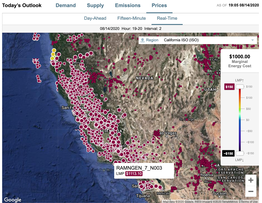PROBLEM:
Revenue-Grade EE and DRAs the grid moves towards decarbonization and more intermittent renewable resources, balancing supply and demand is becoming increasingly critical.
Energy Efficiency and Demand Response have suffered historically from a lack of transparent time and locational performance data, leading to low confidence in the resource by Utility procurement and energy markets. |
SOLUTION:
The FLEXmeter™ combines open-source site-level OpenEEmeter models with automated GRIDmeter comparison groups to provide revenue-grade M&V for both long-term energy efficiency and demand response events.
These new methods incorporate open-source measurement tools and access to privatized smart meter data to produce settlement-quality measurements. |
IMPLEMENTATION:
Settlement-Grade DRThe California Independent System Operator (CAISO) asked Recurve to test the new FLEXmeter methods across a wide range of providers in the state to provide more confidence in the ability of demand-side virtual power plants (demand response) to rapidly balance load and reduce potentially detrimental system peaks.
|
PROJECTDevelop advanced measurement to better assess and harmonize flexibility resources.
|
METHODSCombines CalTRACK model with GRIDmeter comparison groups to deliver settlement-quality results.
|
CODEOpen-source Python code available to all parties without restriction.
|

FLEXmeter builds on the OpenEEmeter and GRIDmeter to establish a robust open source framework for measuring the hourly change in energy consumption for both Energy Efficiency and Demand Response, under one set of rules.
OpenEEmeter and CalTRACK established a set of empirically tested methods that standardized the way normalized meter-based changes in energy consumption are measured and reported.
GRIDmeter offers a set of comparison group sampling methods through stratified sampling or load shape matching to identify non-participant comparison groups. Together, FLEXmeter offers granular energy models that adjust for exogenous factors to calculate changes in energy consumption for both energy efficiency and demand response.
Conventional approaches to measuring Demand Response (DR) have historically struggled to yield accurate results when extreme weather creates non-linear customer usage patterns. Similar challenges have arisen in Energy Efficiency (EE). For example, Covid was a massive non-routine event that rendered traditional M&V methodologies useless.
FLEXmeter derives its consumption baseline both from an advanced site-level model and from a non-participant comparison group. By adjusting portfolios of treated customer impacts by a comparison group of non-participants, FLEXmeter measures the impact of both long-term and dispatchable flexibility, net of exogenous factors such as extreme weather, economic changes, or changing consumer behavior.
OpenEEmeter and CalTRACK established a set of empirically tested methods that standardized the way normalized meter-based changes in energy consumption are measured and reported.
GRIDmeter offers a set of comparison group sampling methods through stratified sampling or load shape matching to identify non-participant comparison groups. Together, FLEXmeter offers granular energy models that adjust for exogenous factors to calculate changes in energy consumption for both energy efficiency and demand response.
Conventional approaches to measuring Demand Response (DR) have historically struggled to yield accurate results when extreme weather creates non-linear customer usage patterns. Similar challenges have arisen in Energy Efficiency (EE). For example, Covid was a massive non-routine event that rendered traditional M&V methodologies useless.
FLEXmeter derives its consumption baseline both from an advanced site-level model and from a non-participant comparison group. By adjusting portfolios of treated customer impacts by a comparison group of non-participants, FLEXmeter measures the impact of both long-term and dispatchable flexibility, net of exogenous factors such as extreme weather, economic changes, or changing consumer behavior.
|
The FLEXmeter utilized Energy Differential Privacy, an emerging best practice in consumer protection that has been used recently by the US Census and Google among others.
The FLEXmeter can for the first time harmonize long-term predictable Energy Efficiency and dispatchable event-based Demand Response. By creating a secondary baseline period it becomes possible to attribute demand flexibility to the correct price signal without double counting, enabling both long-term load shaping and elastic even response under a common set of rules. |
Why Open Source?
Transparent
|
Replicable
|
Available
|
Stakeholder
|
|
Acknowledgments
Thanks to the California Independent System Operator (CAISO) for its support, which allowed Recurve to analyze 38 demand response events spanning Investor-Owned Utility (IOU) and Community Choice Aggregator (CCA) territories across the state, including 11 climate zones, multiple demand response providers (DRPs), and more than 12,000 residential and commercial customers. These methods and open-source code were developed with funding from utilities, regulators, and public agencies. The CalTRACK Methods and OpenEEmeter, now part of the Linux Foundation Energy, was developed with support from California Investor Owned Utilities and Regulators, with input from a large number of national subject matter experts. The GRIDmeter was developed with funding from the U.S. Department of Energy, through the National Renewable Energy Laboratory. Recurve would also like to thank MCE for initially supporting this project by providing secure access to data. |

















